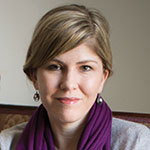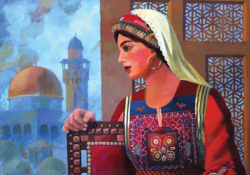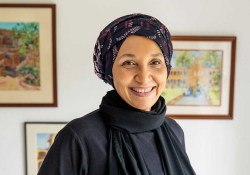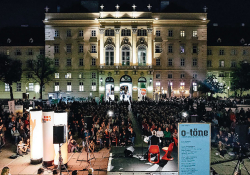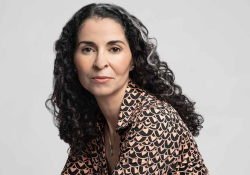The View from Elsewhere: A Conversation with Aminatta Forna

Happiness, Aminatta Forna’s fourth novel, is a complex love letter to London that examines with great delicacy how the city both shelters and challenges the people—and animals—who call it home (see WLT, Nov. 2018, 70). Born in Scotland and raised in Sierra Leone and the UK, Forna is a cosmopolitan writer who probingly explores how places shape their inhabitants, native and nonnative alike. Starting with her excellent memoir, The Devil That Danced on the Water, which documents Sierra Leone’s descent into civil war through the tribulations of her dissident father, Mohammed, Forna’s work pays special attention to how people are changed, for better or worse, in the crucible of history. She sat down to speak with Keija Parssinen about writing, Sierra Leone’s civil war and its aftermath, and narrative identity. The following is an excerpt from their exchange.
Keija Parssinen: What drives you to write?
Aminatta Forna: You know, when I get an idea for something, it’s usually because something is bothering me. There’s something I wish to describe or start a conversation about. I do nurse ideas for novels for a long time, and I would say that if you look at the span of my career, it’s been an ongoing conversation from The Devil That Danced on Water all the way through to Happiness, taking place in five different parts, a memoir and four novels. I think what novelists do is bring into relief something that’s been hiding in plain sight. And the particular position I occupy in the world, which is one of great privilege because I have an extraordinary range in my vantage point, allows me to see some things perhaps more sharply than others might. Therefore, I feel that something I can do and am interested in doing is describing what it might look like from elsewhere, the view from elsewhere.
I think what novelists do is bring into relief something that’s been hiding in plain sight.
Parssinen: When you have that question you’ve been turning over in your mind, how do you begin a new work? What’s the first step?
Forna: I’ll start with fiction because I think The Devil That Danced on Water is self-evident; I mean, that was really about seeing the story. I saw the story because we were that far away from the events which had taken place in the 1970s, and I had many pieces of information, but what I didn’t have was this perspective over the twenty-five intervening years and the connection between the events in my family and the war. That came into relief for me personally. And then suddenly I saw the whole narrative. I saw how all the elements fit together. Often with novels it’s about collecting different parts; I get a pebble, and then I find another pebble, and then I find another pebble, and sometimes they never amount to anything, and then sometimes you see a pattern.
So, for example, with Ancestor Stones, it was very much about hearing a voice. I don’t mean that in a spooky way; no one was talking in my head at night. But it came out of talking to the older members of my family about Sierra Leone’s long-distant past, eighty years before, and just thinking that I hadn’t heard that voice in fiction, I really hadn’t heard women of this kind tell stories of this kind about what life was like in virtually precolonial Sierra Leone—well, they weren’t exactly precolonial, but colonial influence was not felt where they were—so Ancestor Stones came out of that, of wishing to give voice to those kinds of stories and to those kinds of people, inspired very much by listening to one of my elder aunts tell a story from the past. The story is not part of Ancestor Stones, which is fabricated, but that voice was hers. That was the voice I was trying to evoke, older women who knew that world.
The Memory of Love was prompted by the character of Elias Cole, and he was very much inspired by talking to older Sierra Leoneans who’d been around in the 1960s and ’70s when the country had first taken the wrong turn on the path, finding them not many years after the end of the war, reconceiving their past in a way that would be more palatable and exculpating them from any kind of guilt or role in the things that had happened. There was a particular incident with somebody who then became a good friend of mine. I was interviewing her parents for The Devil That Danced on the Water, they were academics, and I asked, “What did you do when the first arrests took place?” And their answers took me aback because they were so evasive, and other people at that point had been pretty frank with me. But these people said, “Well, what do you mean, what did we do?” So I said, “Well, what was the reaction on campus? Were there any protests, were any letters written?” And they got quite defensive and said, “I don’t know what you’re asking, I don’t know what you’re asking.” I was prepared to leave it, but the young woman who I didn’t know was a human-rights lawyer, suddenly banged the desk and said, “She’s asking you what you did, she’s asking you what you did.”
She got in touch with me a long time later and said that she talked to her parents about this later, and her father had said to her, “Well, what could we do, I couldn’t do anything, I had five children. I couldn’t.” And I thought, “Well, gosh, my father’s answer was completely the opposite. I had children so I had to.” So I thought that was really interesting: What is the story someone like that tells themselves about it? . . . How does the next generation feel about that? So I started thinking, for all that I had a father who was murdered, how much worse it would be to have a father who had failed to act?
Parssinen: There’s that great quote from your second novel, The Memory of Love, that says, “It doesn’t take courage to survive, it takes cowardice.”
Forna: Yes. So that drove the idea, and the other characters evolved over time. The character of Adrian was prompted by an encounter I had with an astonishingly ignorant British psychologist in Sierra Leone, a very brief encounter, but it was seared on my brain.
Parssinen: But what’s remarkable about Adrian is that even though he comes out of this encounter you had with someone who was completely ignorant, he’s not just a rube, he’s not a stand-in for Western ignorance.
Forna: No, he grows, he’s capable of change. So these are my pebbles. I carried Elias Cole around for a long time.
Parssinen: A year? Two years?
Forna: I came across that family when I was doing The Devil That Danced on the Water, and I guess the next few years I was encountering more and more people like that, as we got further and further away from the war. People began to realize that there was this national conversation being had, this retrospective national conversation being had. I found more people who were doing that, beginning to rewrite their own narratives.
Parssinen: When you talk about a retrospective national conversation, was that done in any formal capacity?
Forna: Well, no. In terms of a formal capacity, in terms of a truth and reconciliation, and special courts, both of which were very problematic institutions, they did produce this kind of ripple effect. But in newspapers people were reprinting my father’s letter of resignation, as well as his final letter before he died, which was the one in which he said we were on the path to war. So it was being carried out in the newspapers, it was being carried out on university campuses, and I was giving talks and my talks were just packed, people were hanging out of window frames, there was this real hunger to answer the question of How did we get here?
Parssinen: And this was just after the publication of The Devil That Danced on the Water?
Forna: It was around that time, from 2000 on. The Devil That Danced on the Water was published in 2002, so I’d say that conversation went from 2000 for the next six or seven years, or a decade, even. It’s probably still going on. So it took place in different quarters and in different forms. I’m reminded of the post-Pinochet conversation in Chile, and Ariel Dorfman talking about why he wrote Death and the Maiden as a play—he was better known for his poetry at the time, as I recall—instead of as a novel, and he said that it’s because he wanted there to be a public moment where everyone was in the same room, a lot of people gathered together, and he wanted to force that conversation and force that confrontation. So that’s the kind of thing that was happening in Sierra Leone. The Devil That Danced on the Water played a role in it, but that conversation was being had through the special court, through the newspapers in villages.
There were various elements that produced The Hired Man. . . . I wanted to carry on writing about civil conflict, but I felt I’d written quite a lot about Sierra Leone, and I was very attracted to the war in Croatia because it was contemporaneous and because the way that it had been reported was so utterly different from the way the Sierra Leone war was reported. You know, when it was published, I got all this Why Croatia? I was so baffled by the narrow thinking displayed by journalists.
Parssinen: Why Croatia in terms of why you chose to write about Croatia?
Forna: Yeah, I expected it was stark staringly obvious! Is this the impact of race? Because Croatians are a different color from me, why would I have any interest in them? Is that what it is? I don’t know, maybe you can tell me. I was so baffled by their bafflement. To me there was a straightforward intellectual inquiry: Here’s a civil war that was exactly contemporaneous, and if you look at the two countries, they’re exactly the same. Same economy. Same size. Same size population. Coastline. Agriculture-based economy. Twenty-five years of dictatorship followed by an economic downturn and then a civil war. All the elements were the same. And yet to read about any of it in the media, all those things seemed to pass reporters by. And the strange thing was that my Croatian friends, when they said us (to me), they meant Sierra Leoneans and Croatians, that we were the ones who had something in common, and they regarded other westerners, British people, as being the ones who were different, whereas when British people talked about it they would regard themselves as being in with Croatia and Africa as being different. The odd thing was that Croatians didn’t find it peculiar that I wrote about their country. I wasn’t published in Croatia because the economy still has great difficulties, but The Hired Man was published in Slovenia, and I had many invitations to speak, and Croatian people would turn up at my readings and buy ten books and take them back to Croatia. They’re completely interested in having this conversation: How does someone who’s experienced a war in one place see the war in our country?
Parssinen: They weren’t bothered by the fact that you weren’t from there, you weren’t one of them.
Forna: No. In fact, somebody said to me, “Only someone like you could do it because if any Croatian writer had done it they would have been accused of being partisan.”
Parssinen: The Hired Man was a geographic departure for you but not a thematic one. That was a risk, and in hearing you talk about the way it was received, the confusion about your interest in that topic shows that it was an artistic risk. Did you feel that it would be that way? Did you sense as you were writing it that it would be an issue?
Forna: I didn’t anticipate the scale. My publisher’s eyes widened slightly, but they were fine with it, they had enough imagination. When we were doing the publicity for it, the publicists and I tried to preempt the obvious. Mostly the critics didn’t want to appear quite so crass, but save for one, they all mentioned my race and my gender in the reviews, and the fact that Duro was white and male. The reviews were extremely good, they went on to be very positive about it, but the fact was that they felt they had to mention it. The interviewers would always ask me, “Why Croatia?” and I would just think, “How can you bring yourself to ask me that?” I thought, this is an imaginative art, what am I going to do, write the same story over and over again?
Parssinen: In analyzing one of his countrymen’s response to his kidnapping at the hands of Iraqi militants in Happiness, Attila says, “Our [Africans’] expectations of life are more modest than the Europeans. What I mean to say is that the script of life for most of us is, dare I say, a great deal more fluid. In other words, we know shit happens.” Attila also says something similar to Adrian in The Memory of Love. Can you touch on this notion of expectations for one’s life, these regional differences we’ve been talking about, and how it informs our understanding of trauma and its aftermath?
So I think environment hugely shapes outlook, much more so than something as basic as gender.
Forna: To grow up in a country like Sierra Leone, where you are at the mercy of so many elements all the time, if you think about the village where a lot of my extended family live, they’ve dealt with two cholera outbreaks, lost all their harvest in a fire caused by a lightning strike, had a locust invasion once, a civil war, of course, and then Ebola, so you just are going to have a very different outlook from someone who’s never faced anything like that. I think of a character like Duro; he hunts for his own food, he knows the landscape intimately because that’s the kind of people they are, they’re close to the land; he’s going to have a different outlook from someone for whom meat is something you pick up at the supermarket. So I think environment hugely shapes outlook, much more so than something as basic as gender.
Recently I’ve grown interested in the idea of narrative identity. That’s a phrase that I didn’t know when I wrote The Memory of Love or Happiness, but I’ve been working on an academic paper about how the way in which we view the world informs our sense of ourselves and also our response to trauma, and the concept of narrative identity is relatively simple. It’s that each of us constructs a narrative for ourselves and that narrative is built on what a wider society tells you, the kinds of stories your parents tell you as you grow up, and how you make sense of those stories, in terms of your own experience. So you can construct narrative identity. We all have one, and some people will have a much more shared narrative identity than others. People who all grow up in the same village in the same way, or in the same city, in the same era, are going to have quite similar narrative identities.
Each of us constructs a narrative for ourselves and that narrative is built on what a wider society tells you, the kinds of stories your parents tell you as you grow up, and how you make sense of those stories, in terms of your own experience.
There’s a piece of work, for example, on the different narrative identities of Israeli settler kids and Palestinian kids. And they’ve got very different narrative identities based on the stories they’re told by the outside society. So the Palestinian kids are constantly given stories of loss and of sacrifice, and the Israeli kids are given stories of resistance and endeavor, success through endeavor. People who look at conflict resolution are now looking at narrative identity as something that you have to know before you go in to try to bring certain groups together. The way that narrative identity affects trauma has to do with what expectations you grow up with.
Something you hear very often in terms of the Western experience of suffering is “my life was ruined.” That’s something I have a real problem with—people being told that their lives are ruined. That is the contentious bone at the center of the study of trauma and resilience, and this is something that Boris Cyrulnik identified as the biggest obstacle to overcoming trauma. If you believe your life is ruined, then your chances of overcoming that trauma are going to be adversely affected. He saw that otherwise well-intentioned mental health professionals were treating kids that had encountered violent or terrifying situations as though they were already damaged, already lost causes.
So narrative identity shapes us in all these ways. When someone’s narrative identity excludes the idea of suffering, they have fewer tools with which to handle the resulting trauma than someone whose narrative self is differently constructed. Cultural trauma theory has always looked at this idea of empathy, writing about trauma as producing empathy, which I think is correct. I was reading about Susan Sontag talking about the pain of others, where she says: Should we look at these things, are we being prurient, does it serve a purpose?
The most important thing about writing about trauma is to give agency, to reflect people’s trauma in a way that makes sense of what has happened to them in the wider picture of the world and doesn’t leave them feeling like an exhibit of damage.
Parssinen: Looking back at traumatizing events?
Forna: With Sontag it was about looking at photographs of other people’s suffering. When I think about literature, what purpose does observing suffering through literature serve? The cultural trauma theorists of the 1990s said it can evoke empathy, and I think that’s right. I think the danger is empty empathy, where we just look and listen and nothing comes out of it. I think the most important thing about writing about trauma is to give agency, to reflect people’s trauma in a way that makes sense of what has happened to them in the wider picture of the world and doesn’t leave them feeling like an exhibit of damage.
October 2018
